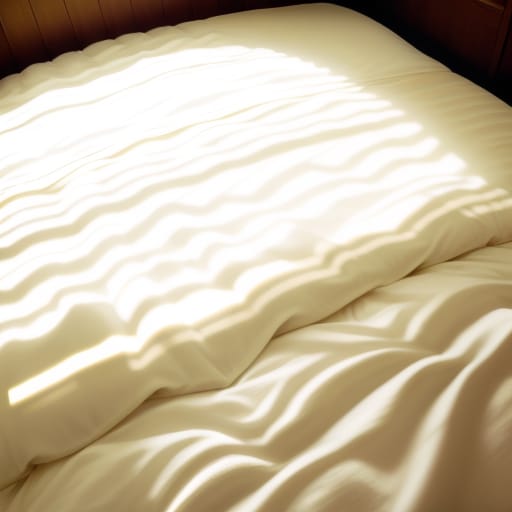Down comforters are known for being incredibly warm, comfortable, and luxurious. However, one common issue that many down comforter owners face is clumping. This is when the down filling inside the comforter bunches together into lumps, instead of remaining evenly distributed.
Clumping can make your down comforter feel lumpy and uneven. It also reduces the insulation and warmth, since there will be thin spots where filling is missing. Excessive clumping can even damage the baffle-box stitching that separates compartments inside the comforter.
Luckily, clumping is easy to prevent with proper care and maintenance. And even severe clumps can be fixed with some simple techniques. This beginner’s guide will teach you everything you need to know about keeping your down comforter in top condition and free of clumps!
Understanding Down Comforter Clumping
Before we dive into solutions, let’s take a minute to understand why down comforters clump in the first place.
The filling inside a down comforter is made up of tiny, soft clusters of down feathers. These feathers are very lightweight and designed to trap warm air.
However, over time gravity causes the down to shift and settle at the bottom of the comforter. Friction from normal use can also cause the feathers to tangle and stick together. Heat and humidity speed up this process.
If the down stays clumped in one area for too long, it can permanently compress and lose its loft. This leaves you with a lumpy, uneven comforter with reduced insulation.
Regular maintenance is key to keeping your down comforter fluffy and evenly filled. With some simple preventative measures and re-fluffing techniques, you can stop clumps in their tracks and prolong the life of your comforter.
Preventing Down Comforter Clumping
Here are some tips to prevent clumping before it starts:
Shake and Fluff Daily
- Give your down comforter a quick shake or fluff when you get out of bed in the morning. This will redistribute the filling and prevent clumps from forming while it’s stored all day.
- For a quick fluff, stand at the foot of the bed, grasp the corners of the comforter, and lift it up about a foot. Give it 2-3 forceful shakes to disperse the down.
Store Properly
- Don’t compress your comforter into a tight space for long periods. Let it relax and loft fully when not in use.
- Store in a large, breathable cotton or mesh storage bag. Avoid plastic bags that can cause moisture buildup.
- If storing long term, lay flat and smooth out folds to maintain even distribution of the down.
Use a Duvet Cover
- A snug duvet cover provides an outer shell that prevents the down from shifting around easily. It also protects the comforter from dirt and friction damage.
- Change duvet covers 2-4 times per year and wash the comforter alone 1-2 times per year.
Avoid Heavy Pressure
- Don’t allow heavy weight to compress one area of the comforter for prolonged periods. This can permanently flatten the down.
- For example, avoid letting kids or pets sleep or play on top of the bare comforter. Use a top sheet or duvet cover as a barrier instead.
With some simple preventative care, you can stop minor clumping before it starts and prolong the lofty life of your down comforter.
Fixing Down Comforter Clumps
But what if clumps and flat spots have already formed? Not to worry – here are some techniques to redistribute the down and restore fluffiness:
Manual Fluffing
- Lay the comforter flat and massage any clumped up areas with your hands. Knead and squeeze gently to break up compacted down.
- Focus on seams where the baffle-box stitching separates compartments that can contain clumps.
- Finish by grabbing the corners, lifting up, and forcefully shaking 2-3 times.
Tennis Balls in the Dryer
- Place 2-3 tennis balls into a large dryer along with the comforter on air fluff or low heat.
- The tumbling action helps break apart clumps and re-distribute filling.
- Check frequently and remove as soon as the comforter is fully re-lofted to prevent over-drying.
- Dryer balls can be used instead of tennis balls for a more eco-friendly option.
Check for Residue
- Sometimes clumped down is caused by residue sticking feathers together. This could be from body oils, fabric softener, etc.
- Check for built-up residue by rubbing a white cloth over the surface of the comforter.
- Spot clean any areas of residue buildup following the care instructions.
With some periodic fluffing sessions and spot cleaning as needed, you can break apart minor clumps and restore even distribution of the down.
Washing and Drying Techniques
For more stubborn, set-in clumps or flat spots, a thorough wash and dry cycle may be needed:
Wash Properly
- Wash the comforter on its own in a large capacity front-load washer. Top-load agitator washers can damage the baffle-box stitches.
- Use a mild, front-load detergent. Skip fabric softener, as it can cause buildup.
- Wash on a low-agitation delicate cycle. Additional rinses help fully remove detergent.
Dry Thoroughly
- Move to an extra-large capacity dryer, as you need lots of room for the down to re-loft and circulate.
- Add 2-3 tennis balls to help break up clumps. Or use dryer balls.
- Run on low heat for 2-3 hours until fully dried. Check frequently to avoid over-drying.
- You may need to pause and manually redistribute clumps halfway through.
Proper washing and thorough drying is key to fully removing set-in clumps and restoring even distribution and loft.

Down Comforter Care Tips
Here are some additional maintenance tips for keeping your comforter in top shape:
- Rotate – Switch the direction you lay the comforter on the bed to promote even fill distribution.
- Inspect – Periodically check for small clumps you can manually break apart before they grow.
- Maintain – Wash 1-2 times per year, more if you own pets. Dry clean for stubborn odors.
- Professionally Clean – Many dry cleaners offer down refreshing services to thoroughly clean and re-fluff.
With proper care, your down comforter should provide many years of cozy warmth with minimal clumping issues.
Advanced Clump Removal Techniques
For comforters with severe, long-term clumping that resists basic fluffing attempts, you can try these advanced tactics:
Wet and Redry
- Lightly mist clumped areas then manually work apart, knead, and squeeze clumps while damp. The moisture helps loosen the feathers.
- Allow to fully air dry, periodically flipping and massaging.
- Finish by placing in the dryer with tennis balls to complete fluffing process.
Sneakers in the Dryer
- Clean, dry sneakers (tied together) act as large balls to help tumble and redistribute the down.
- Check frequently and pause to manually break apart clumps mid-cycle as needed.
Use Large Dryers
- Look for an oversized, commercial-grade dryer at a laundromat.
- The extra space and tumbling action helps re-loft compressed areas better than standard dryers.
- Take your time and run multiple drying cycles, checking frequently to prevent over-drying.
While challenging, even severely clumped down can be refreshed and restored with some extra work.
When to Consider Replacement
However, if clumping and flat spots persist after trying all methods, the down fill may be permanently compressed. Signs it’s time to replace your down comforter include:
- Severe clumping that resists redistribution
- Visible ripped baffle-box stitching
- Insulation value feels reduced despite efforts
- Down has shifted and no longer lofts
If the condition of the filling itself has degraded, it may be time to invest in a new down comforter. With proper care from the start, a quality down comforter can last over a decade.

Simple Way for Caring Your Down Comforter
Caring for a down comforter properly involves consistent, simple maintenance:
- Shake and fluff daily to prevent clump formation
- Allow the down to fully loft when not in use
- Protect with a snug duvet cover
- Wash 1-2 times per year in a large, front-load washer
- Dry thoroughly on low heat with tennis balls
- Check for and manually break up small clumps frequently
- Consider professional cleaning services for deep refreshing
Following these tips, you can keep your down comforter evenly filled and luxuriously lofty for years of blissful warmth. Don’t let clumping issues force you into premature replacement. With some basic TLC for your comforter, you can relax and enjoy the feeling of being enveloped in a fluffy, feather-filled hug.
Frequently Asked Questions
What causes down comforters to clump?
Down comforters clump when the lightweight down filling shifts and bunches together inside the comforter. Over time, gravity causes the down to settle at the bottom. Friction and humidity also cause the soft down feathers to tangle and clump together.
How can I prevent my down comforter from clumping?
Prevent clumping by shaking and fluffing your down comforter daily to redistribute the filling. Allow it to fully loft when not in use. Use a duvet cover to protect the comforter. Avoid compressing it for long periods and wash 1-2 times per year.
What is the best way to fix a clumped down comforter?
For minor clumps, fluff manually and use tennis balls in the dryer to break them apart. For severe clumping, wash in a large capacity front-load washer and dry thoroughly on low heat with tennis balls to re-loft the down.
When should I consider replacing my down comforter?
If clumping and flat spots remain after trying all fluffing and washing methods, the down fill may be permanently compressed and damaged. Down that no longer lofts and damaged baffle-box stitching are signs it’s time for replacement.
How often should I wash my down comforter?
Only wash a down comforter 1-2 times per year. More frequent washing can damage the down feathers. Spot clean as needed between washes. Use a duvet cover to protect the comforter from buildup. Periodically dry clean for deep cleaning and refreshing.








